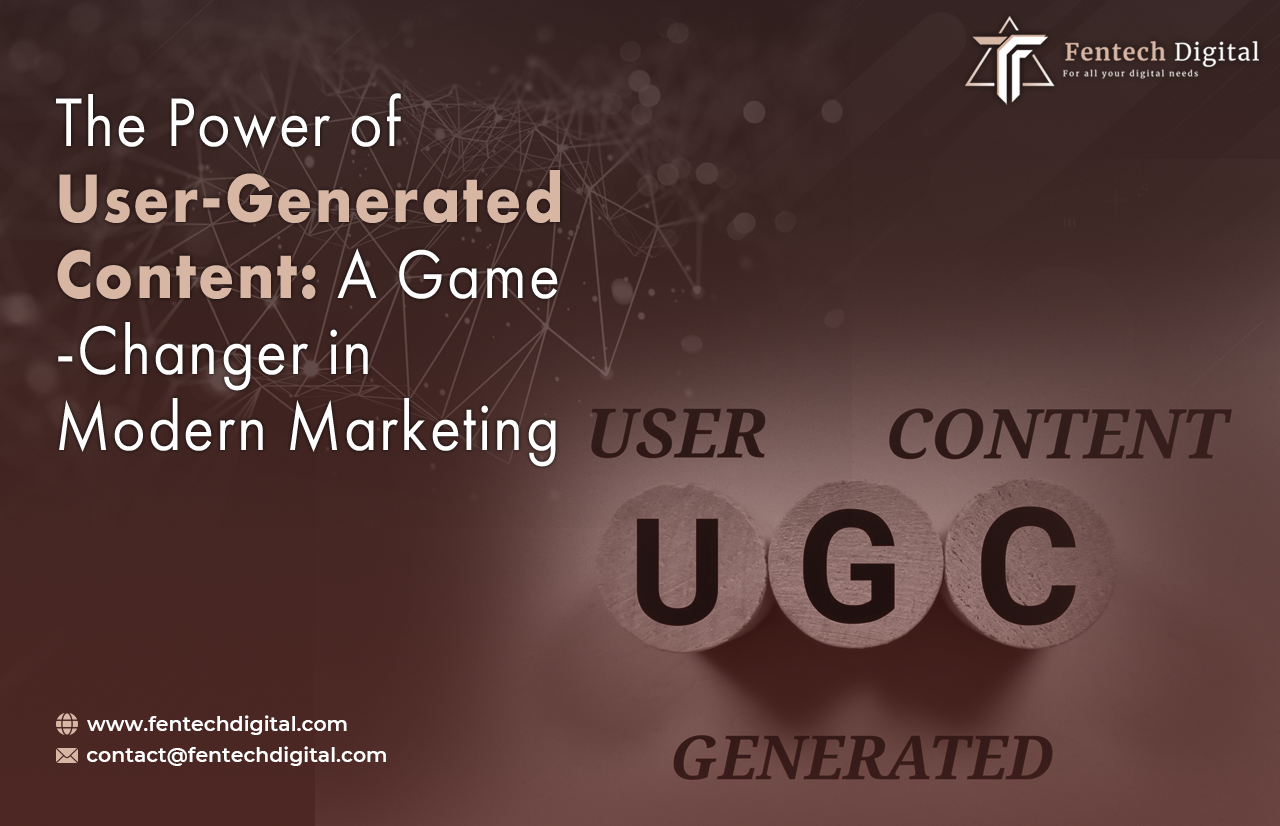The Power of User-Generated Content: A
Game-Changer in Modern Marketing
October 9, 2024

Did you know that a staggering 93% of consumers trust user-generated content (UGC) more than traditional advertising when making purchasing decisions? (Source: Adweek)
What is User-Generated Content (UGC)?
UGC refers to any content created and shared by individuals, rather than brands, that showcases their experiences, opinions, or interactions with a product or service. This can include social media posts, reviews, testimonials, photos, videos, and more.
Why is UGC Valuable?
UGC is incredibly valuable for modern marketing strategies because it provides:
– Social proof: Builds trust and credibility with potential customers
– Authenticity: Offers a genuine perspective on a product or service
– Reach: Expands your audience through shared content
– Engagement: Encourages interaction and participation
Our Focus: Leveraging UGC for Marketing Success
In this blog, we’ll explore the ways to effectively use UGC to enhance your marketing efforts, including:
– Strategies for encouraging and collecting UGC
– Best practices for showcasing UGC in your marketing campaigns
– Tips for measuring the impact of UGC on your brand
– Examples of successful UGC campaigns to inspire your own efforts
What Is User-Generated Content?
Definition of UGC
User-Generated Content (UGC) is content created by users or customers that promotes your brand, product, or service. This content is generated by individuals rather than your brand, making it a powerful marketing tool.
Types of UGC
– Social Media Posts: Social media platforms like Instagram, Facebook, and Twitter are rich sources of UGC.
– Reviews: Customer reviews on websites, apps, and social media.
– Testimonials: Quotes, stories, or experiences shared by satisfied customers.
– Photos: User-generated photos showcasing products, services, or experiences.
– Videos: Customer-created videos demonstrating products, services, or experiences.
– Blog Posts: User-generated articles sharing experiences, tips, or expertise.
Why UGC Resonates with Consumers
– Authenticity: UGC is perceived as more genuine and trustworthy compared to brand-generated content.
– Relatability: Consumers can easily relate to fellow customers’ experiences and opinions.
– Social Proof: UGC provides evidence that real people have used and benefited from a product or service.
– Engagement: UGC encourages interaction and participation, fostering a sense of community.
– Credibility: UGC builds trust and credibility for your brand, as customers are more likely to believe their peers.
The Power of UGC
UGC has become a crucial aspect of marketing strategies, as it provides a unique opportunity to showcase real customers’ experiences and build trust with potential customers. By leveraging UGC, businesses can create engaging experiences that resonate with their target audience and drive conversions.
Benefits of Using UGC in Marketing
Builds Trust and Authenticity
User-Generated Content (UGC) helps build trust and authenticity with your audience by showcasing real customers’ experiences and opinions. This helps potential customers relate to your brand and feel more comfortable making a purchase.
Boosts Social Proof and Enhances Credibility
UGC serves as social proof, demonstrating that real people have used and benefited from your product or service. This enhances your brand’s credibility and makes it more likely for potential customers to trust your brand.
Increases Engagement and Encourages Community Participation
UGC encourages engagement and community participation by inviting customers to share their experiences and opinions. This helps create a sense of belonging and fosters a loyal community around your brand.
Cost-Effective Way to Source Marketing Materials
UGC provides a cost-effective way to source marketing materials, reducing the need for expensive content creation. This helps businesses save time and resources while still achieving their marketing goals.
Additional Benefits
*Improves brand awareness and reach
*Enhances website SEO
*Supports influencer marketing efforts
*Provides valuable customer insights
*Helps with content ideation and creation
Encourage Your Customers to Share
Ask for UGC in an Organic Way
– Start a Conversation: Engage with customers and ask about their experiences with your brand.
– Use Open-Ended Questions: Encourage customers to share their stories and opinions.
Create Branded Hashtags
– Unique and Memorable: Develop a hashtag that stands out and is easy to remember.
– Consistent: Use the hashtag across all social media platforms.
Run UGC-Focused Campaigns
– Contests: Host photo or video contests that encourage customers to share their content.
– Challenges: Create fun and engaging challenges that incentivize customers to participate.
– Q&A Sessions: Host Q&A sessions and ask customers to share their experiences.
Incentivize Users
– Giveaways: Offer prizes or discounts for participating customers.
– Features: Feature customer content on your website or social media profiles.
– Exclusive Offers: Provide exclusive discounts or offers to customers who share their content.
Make it Easy to Share
– Add a CTA: Add a “Share Your Story” section to your website or social media profiles.
– Use Social Media: Use social media to encourage customers to share their content.
Engage with Customers
– Respond: Respond to customer content and engage with their stories.
– Show Appreciation: Thank customers for sharing their content.
Showcase UGC
– Highlight: Highlight customer stories and content on your website or social media profiles.
– Demonstrate Impact: Demonstrate the impact of UGC on your brand.
Showcase UGC Across Different Channels
Incorporate UGC on Your Website
– Testimonials: Highlight customer testimonials on your homepage or about page.
– Product Reviews: Display product reviews and ratings on product pages.
– Photos: Showcase customer photos on product pages or in a dedicated gallery.
Leverage UGC on Social Media
– Increased Engagement: Share UGC on social media to increase engagement and reach.
– User-Generated Content Campaigns: Run social media campaigns that encourage customers to share their content.
– Social Media Contests: Host social media contests that incentivize customers to share their content.
Use UGC in Email Marketing
– Build Trust: Use UGC in email marketing campaigns to build trust and connection with customers.
– Customer Stories: Share customer stories and testimonials in email campaigns.
– Exclusive Offers: Offer exclusive discounts or offers to customers who share their content.
Use UGC in Advertising
– Social Proof: Use UGC in advertising to demonstrate social proof and credibility.
– Influencer Marketing: Partner with influencers to showcase UGC in advertising campaigns.
– Retargeting Ads: Use UGC in retargeting ads to re-engage customers.
Measure and Optimize UGC
– Track Engagement: Track engagement metrics (e.g., likes, comments, shares) to measure UGC success.
– Analyze Sentiment: Analyze sentiment to understand customer opinions and preferences.
– Optimize UGC: Optimize UGC campaigns based on performance data.
Collaborate with Influencers and Brand Advocates
Partnering with Influencers
– Authentic UGC: Partner with influencers to generate authentic UGC that resonates with their audience.
– Relevant Audience: Choose influencers who have a relevant audience that aligns with your brand.
– Exclusive Content: Collaborate with influencers to create exclusive content that showcases your brand.
Identifying and Nurturing Brand Advocates
– Natural Loyalty: Identify customers who naturally share content about your brand.
– Empower Advocates: Nurture and empower brand advocates to continue sharing their experiences.
– Exclusive Offers: Provide exclusive offers or rewards to brand advocates.
Best Practices for Maintaining a Relationship with UGC Creators
– Clear Communication: Clearly communicate your brand’s message and guidelines.
– Respect Boundaries: Respect the creative boundaries and ownership of UGC creators.
– Show Appreciation: Show appreciation and gratitude for UGC creators’ content.
– Ongoing Collaboration: Collaborate with UGC creators on an ongoing basis to maintain a strong relationship.
Legal Considerations When Using UGC
Importance of Permission
– Avoid Legal Issues: Get permission before using user-generated content to avoid legal issues.
– Respect Users’ Rights: Respect users’ rights and privacy by obtaining consent.
Complying with Copyright Laws
– Understand Copyright: Understand copyright laws and how they apply to UGC.
– Use Public Domain: Use public domain or Creative Commons licensed content.
Privacy Policies
– Be Transparent: Be transparent about how you’ll use UGC and obtain consent.
– Comply with Regulations: Comply with privacy regulations like GDPR and CCPA.
Obtaining Consent
– Direct Messages: Ask for consent via direct messages or email.
– Terms and Conditions: Include UGC terms and conditions on your website or social media profiles.
– Simple Language: Use simple language to explain how UGC will be used.
Best Practices
– Keep Records: Keep records of consent and UGC usage.
– Respect Withdrawal: Respect users’ rights to withdraw consent.
– Be Mindful: Be mindful of cultural and sensitive content.
Monitor and Curate High-Quality UGC
Tracking UGC
– Hashtag Campaigns: Use branded hashtags to track UGC.
– Mention Tags: Monitor mention tags on social media.
– Reviews and Ratings: Track reviews and ratings on your website and social media.
Curating UGC
– Quality Over Quantity: Prioritize high-quality UGC that aligns with your brand.
– Relevance: Choose UGC that is relevant to your brand and audience.
– Diversity: Select UGC that showcases diverse perspectives and experiences.
Tools and Platforms
– Taggbox: Use Taggbox to find and organize UGC.
– TINT: Leverage TINT to curate and display UGC.
– Social Media Management Tools: Utilize social media management tools like Hootsuite or Sprout Social.
Maintaining a Consistent Brand Image
– Brand Guidelines: Establish brand guidelines for UGC usage.
– Visual Identity: Ensure UGC aligns with your visual identity.
– Tone and Voice: Maintain a consistent tone and voice across all UGC.
Best Practices
– Regularly Update: Regularly update your UGC to keep it fresh and engaging.
– Give Credit: Always give credit to the original creator of the UGC.
– Engage with Creators: Engage with UGC creators to build relationships and encourage more content.
Analyze the Impact of UGC on Your Campaigns
Tracking UGC Success
– Engagement: Monitor likes, comments, shares, and other engagement metrics.
– Conversions: Track sales, sign-ups, and other conversion metrics.
– Brand Awareness: Measure increases in brand mentions, hashtag uses, and social media followers.
Measuring UGC Impact on ROI
– Revenue Growth: Attribute revenue growth to UGC campaigns.
– Cost Savings: Calculate cost savings from reduced content creation.
– Customer Acquisition: Measure the impact of UGC on customer acquisition costs.
Measuring UGC Impact on Customer Loyalty
– Retention Rates: Track customer retention rates.
– Net Promoter Score: Measure customer satisfaction and loyalty.
– Advocate Engagement: Monitor engagement from brand advocates.
Optimizing Future UGC-Driven Campaigns
– Insights: Use data insights to identify top-performing UGC types and channels.
– Refine Targeting: Refine targeting based on UGC engagement data.
– Content Strategy: Adjust content strategy to align with UGC trends.
– Influencer Partnerships: Identify and partner with influential UGC creators.
Conclusion
Recap of Key Steps
– Identify and Collect UGC
– Curate and Showcase UGC
– Engage with UGC Creators
– Measure and Optimize UGC Performance
Start Integrating UGC Today
– Enhance Audience Connection
– Boost Engagement
– Build Trust and Credibility
Call to Action
– Engage with Your Audience
– Collect UGC for Your Next Campaign
– Start Leveraging the Power of UGC Today!
By following these key steps and integrating UGC into your marketing strategy, you can create a more authentic and engaging experience for your audience. Don’t wait start collecting and leveraging UGC today to take your marketing to the next level!

